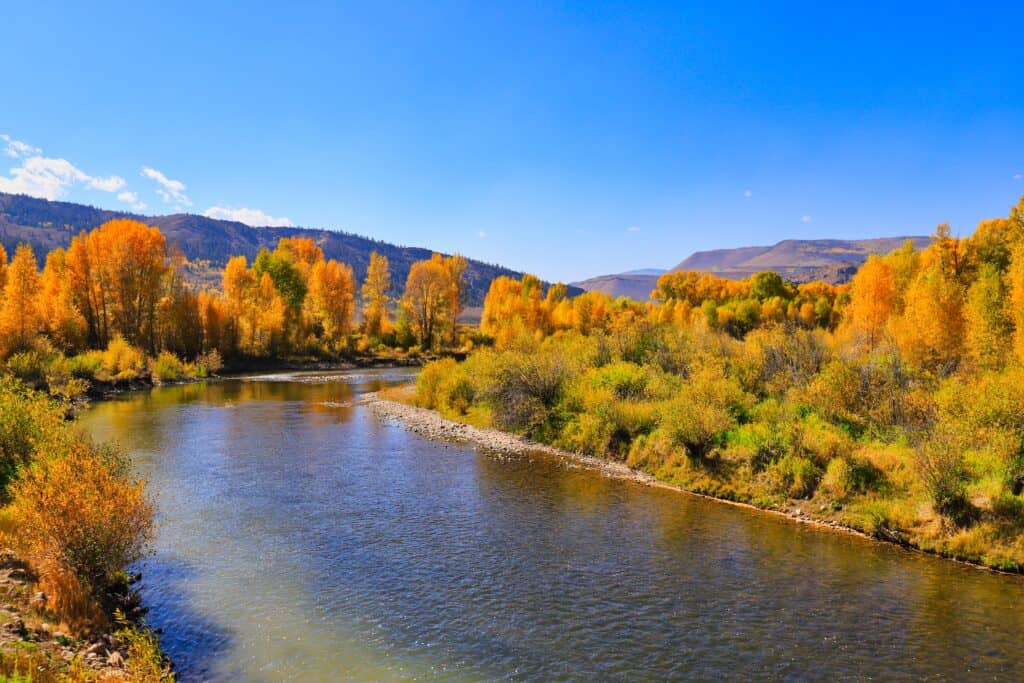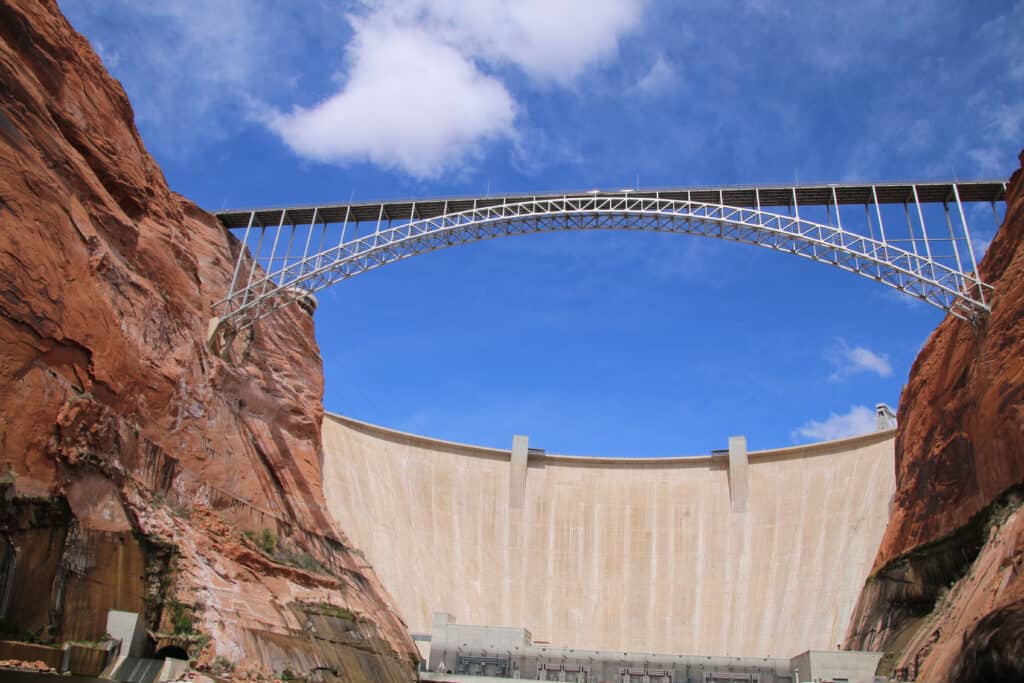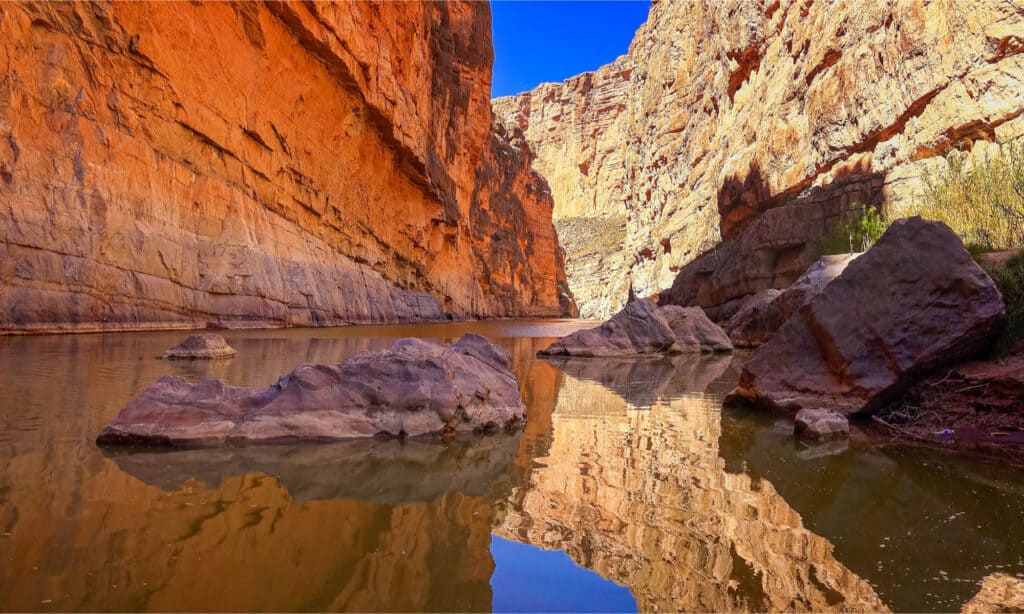The Colorado River is a long watercourse in the western United States. The states reliant on the water in the Colorado River system needed to be regulated so that everyone was treated equally. What is the Law of the River, and why does it still matter today?
Why is the Colorado River Important?

The Colorado River near Granby, Colorado during the fall.
©Simon Morris / Flickr – License
The Colorado River is important because it is the primary water source in an otherwise arid landscape in the western United States. Most of the West is dry and hot, with almost no natural water resources. The Colorado River watershed is so large that it drains twelve percent of the continental United States.
The river begins in the Colorado Rockies and ends in the Mexican desert near the Gulf of Mexico. It’s 1,450 miles long and the sixth-longest river in the United States. The average depth is about twenty feet; however, some parts are up to ninety feet deep.
What is the Law of the River?
The Law of the River is a collection of rules, regulations, laws, and other binding agreements that control the water in the Colorado River watershed. It specifically dictates water rights to anyone reliant on Colorado River water.
These are some of the major pieces of the Law of the River:
- Colorado River Compact of 1922
- Boulder Canyon Project Act of 1928
- California Seven Party Agreement of 1931
- Mexican Water Treaty of 1944
- Upper Colorado River Basin Compact of 1948
- Colorado River Storage Project of 1956
- Colorado River Basin Project Act of 1968
Why Does the Law of the River Matter Today?
The Law of the River matters today because the water in the Colorado River needs governance now more than ever. All aspects of the Colorado River are managed by the Law of the River.
Even with the careful considerations in place today, water in the river has been over-allocated, and adjustments need to be made. The Law of the River is constantly in flux, and it needs to respond to needs as they arise.
Lake Mead and Lake Powell are dramatic examples of the crisis unfolding along the Colorado River. No drastic decisions have been made to address the current exceptional drought conditions; however, any future decisions will become a part of the Law of the River.
Law of the River: Colorado River Compact of 1922
The Colorado River Compact of 1922 established the Upper and Lower Basin states. It divided the Colorado River basin, which contains seven states, into two parts. The Upper Basin has Wyoming, Colorado, Utah, and New Mexico, and the Lower Basin includes Arizona, California, and Nevada.
Since most of the western United States won’t be developed due to a lack of water, how the remaining water is allocated remains a heated debate. Uncontrolled growth on the Colorado River raised concerns that certain states would hog all of the resources while expanding before upstream states could develop. This compact was the first attempt to address these issues.
The 1922 compact is the cornerstone of the Law of the River, from which all other laws are based. While most of the specific details in this original compact have been revised, the framework laid by this compact remains today.
Law of the River: Boulder Canyon Project Act of 1928

The Glen Canyon dam where Lake Powell ends. The bridge across Glen Canyon cuts the blue sky, and red rocks frame the image.
©alanabensonart/Shutterstock.com
The All-American Canal and the Hoover Dam were approved by the Boulder Canyon Project Act of 1928. This allowed for increased storage and control of the water in the Lower Basin, and it also allowed for a greater irrigation capacity in Southern California.
Hoover Dam creates Lake Mead. This dam was also the first major dam authorized on the Colorado River.
A large canal was also approved by this act. The All-American Canal delivers water from the Colorado River to the Imperial Valley in Southern California. This canal is around 80 miles in length and is the longest irrigation canal on the planet.
Law of the River: California Seven Party Agreement of 1931
Before this agreement, trying to negotiate with California was almost impossible. Different water districts demanded individualized contracts, and overlapping interests often came into conflict. This agreement empowered the California government to make overarching decisions for its water districts.
This agreement allocated specific amounts of water to seven different districts in California. These allotments came from the water guaranteed to the state by the previous pieces of the Law of the River. It also established how water delivery systems will work between water districts.
Law of the River: Mexican Water Treaty of 1944

Rio Grande river flows through Santa Elena Canyon in Big Bend National Park.
©CrackerClips Stock Media/Shutterstock.com
This treaty guaranteed that a certain amount of water would be delivered to Mexico annually. Mexico shares water resources with the United States, and this treaty addresses possible disagreements. In the water treaty of 1944, the water resources in the Colorado River and the Rio Grande in Texas were established.
Law of the River: Upper Colorado River Basin Compact of 1948
This compact addressed how the Upper Basin states were going to divide up and manage their share of the water in the Colorado River. The Upper Basin is required to deliver a certain amount of water downstream, but this compact allows them to legally retain excess water despite development in the Lower Basin.
Law of the River: Colorado River Storage Project of 1956
The Colorado River Storage Project of 1956 authorized Upper Basin states to develop the Colorado River and its tributaries to their benefit. The Glen Canyon Dam and the resultant Lake Powell were the biggest authorized project. Hydroelectric power and control of the tributaries within the Upper Basin states were also developed due to this project.
Law of the River: Colorado River Basin Project Act of 1968
The Colorado River Basin Project Act of 1968 authorized the Central Arizona Project (CAP) construction. This project diverts Colorado River water to central and southern Arizona through aqueducts, lakes, dams, and canals.
By the late 1960s, air conditioning was common in most American homes. As a result, the population in hot states started increasing dramatically. This act addressed the infrastructure needed to support this population boom.
Up Next
- How Deep is The Colorado River?
- How Long is The Colorado River?
- Which States Rely On The Colorado River?
The photo featured at the top of this post is © Simon Morris / Flickr – License / Original
Thank you for reading! Have some feedback for us? Contact the AZ Animals editorial team.






